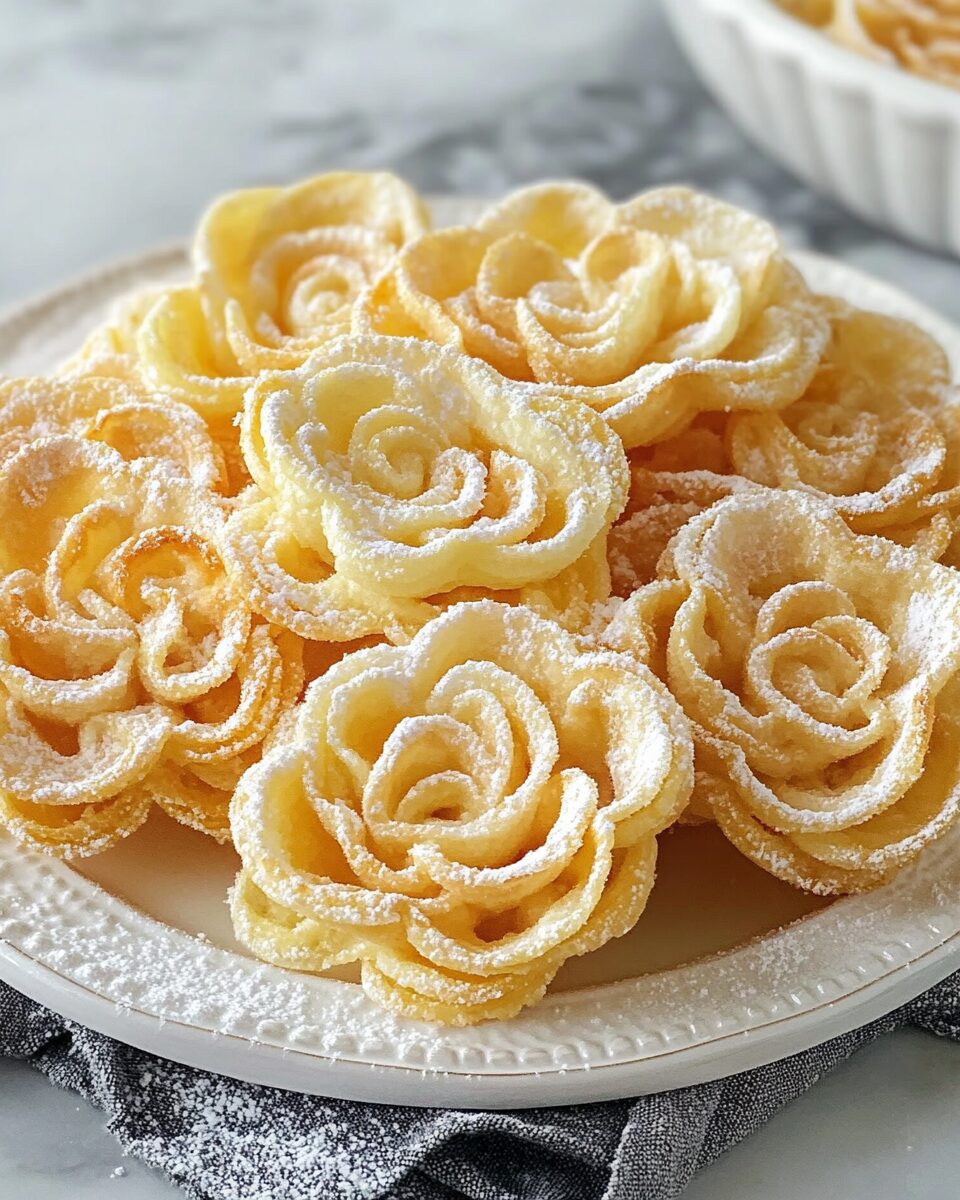History and Origin of Rosettes
Rosettes trace their origins to Scandinavian countries, particularly Sweden and Norway, where they have been a cherished holiday tradition for centuries. The name “rosette” comes from their floral, lace-like appearance, resembling the intricate patterns found in traditional Nordic embroidery. The method of making rosettes has been passed down through generations, with each family adding its unique touch to the recipe.
Why Rosettes Are a Holiday Favorite
Rosettes are a favorite during the holiday season for several reasons. Their delicate and decorative appearance makes them an elegant addition to festive dessert tables. The process of making them is also a cherished family tradition, with multiple generations gathering in the kitchen to prepare and fry these crisp treats together.
Their light, crispy texture makes them an ideal complement to other holiday sweets. Unlike heavier, more filling desserts, rosettes provide a delicate crunch with a subtle sweetness, allowing them to be enjoyed without overwhelming the palate. They pair exceptionally well with coffee, tea, or hot chocolate, making them a comforting winter treat.
How Rosettes Are Made Unique
One of the defining features of rosettes is their distinctive shape, created using a special iron mold. These irons come in various designs, including stars, flowers, and snowflakes, adding to the visual appeal of the pastry. The batter used for rosettes is simple, typically consisting of eggs, sugar, milk, flour, and a touch of vanilla for added flavor.
The technique of frying rosettes requires precision. The iron must be preheated in hot oil before being dipped into the batter, ensuring that the batter adheres evenly. The moment the batter-coated iron is submerged back into the oil, the rosette takes shape, frying to a crisp and golden brown in just a few seconds. Once removed from the oil, the rosettes are carefully slid off the iron and placed on paper towels to drain excess oil. A final dusting of powdered sugar enhances their sweetness and presentation.
Variations and Regional Adaptations
While the traditional Scandinavian rosette recipe remains popular, different regions have put their own spin on the classic treat. Some variations include:
- Chocolate-Dipped Rosettes: Some people like to dip one side of their rosettes in melted chocolate for an extra layer of sweetness.
- Cinnamon Sugar Coating: Instead of powdered sugar, rosettes can be coated in a cinnamon-sugar mixture while still warm.
- Savory Rosettes: While rosettes are typically sweet, some versions use a savory batter with herbs and cheese, making them an interesting snack or appetizer.
- Gluten-Free Rosettes: Many modern recipes adapt traditional rosettes for gluten-free diets by using alternative flours like rice flour or almond flour.
Tips for Making the Perfect Rosettes
Making rosettes can be a bit tricky for beginners, but with the right techniques, they can turn out perfect every time. Here are some tips to achieve the best results:
- Preheat the Iron Properly: The rosette iron must be sufficiently heated in oil before dipping it into the batter. If it’s not hot enough, the batter won’t stick properly.
- Use a Thin Batter: The batter should be smooth and slightly runny to create light and crisp rosettes.
- Avoid Covering the Top of the Mold: When dipping the mold into the batter, ensure the batter doesn’t cover the top, as this will make it difficult to release the rosette after frying.
- Fry at the Right Temperature: Oil should be maintained at around 375°F (190°C) for optimal frying. If the oil is too hot, the rosettes will brown too quickly; if too cool, they will absorb excess oil and become greasy.
- Drain Excess Oil Properly: Placing fried rosettes on paper towels helps remove any residual oil, keeping them crisp and light.
- Store in an Airtight Container: To keep rosettes fresh, store them in an airtight container at room temperature. They can last up to a week if stored properly.
Pairing and Serving Suggestions
Rosettes are incredibly versatile and can be enjoyed in various ways:
- With Whipped Cream and Berries: Serving rosettes with a dollop of whipped cream and fresh berries enhances their flavor and adds a refreshing contrast.
- With Ice Cream: Pairing rosettes with a scoop of vanilla or caramel ice cream creates a delicious contrast between the warm, crispy texture and the cold, creamy ice cream.
- With Hot Beverages: Enjoying rosettes with coffee, tea, or spiced hot chocolate enhances their delicate sweetness and makes for a cozy treat.
Cultural Significance and Modern Appeal
Rosettes hold a special place in Scandinavian culture, symbolizing warmth, togetherness, and festive celebrations. In many Scandinavian homes, the process of making rosettes is a family affair, with multiple generations coming together to share in the joy of creating these delicate treats.
Beyond Scandinavia, rosettes have gained popularity worldwide due to their elegant appearance and delicious taste. They are now a common sight at international food festivals, holiday markets, and specialty bakeries. The rise of social media and food photography has also contributed to their appeal, with their intricate designs making them a favorite for food bloggers and dessert enthusiasts.
Conclusion
Rosettes are a timeless treat that combines tradition, artistry, and delicious flavor in one crispy, delicate pastry. Whether enjoyed during the holidays or as an everyday indulgence, they offer a unique and satisfying experience for those who appreciate the beauty of handmade desserts. Their light, crisp texture and subtle sweetness make them a delightful companion to a cup of coffee or tea.






